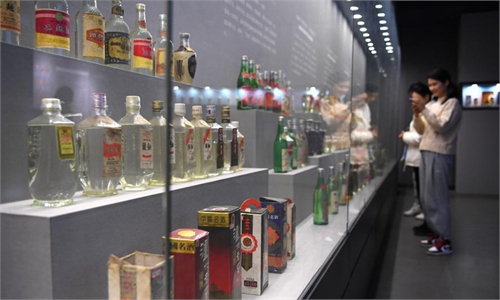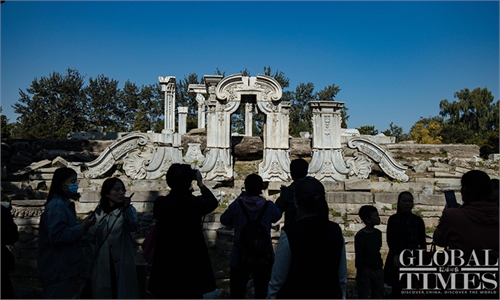ARTS / ART
The Pompidou Centre: key facts about Paris’ famous arts ‘machine’
The Pompidou Centre in Paris, home of Europe's biggest contemporary art museum, is to close for four years from 2023 for a massive refit.
Here are some key facts about the iconic building, which rewrote the rules of architecture in the 1970s:
The Pompidou Centre's radical design pushes almost all of its structural and mechanical elements to the outside - the building appears to have been turned inside out.
That leaves pure gallery space inside a futuristic glass facade laced with multi-colored pipes - blue for air conditioning, green for water and yellow for electricity.
Wags nicknamed it "The Gasworks" and "Notre-Dame of the Pipes" when it opened in 1977.
Yet it quickly became one of France's top cultural attractions, drawing more than 5 million visitors a year.
The Pompidou now ranks after the Louvre museum and the Eiffel Tower as the French capital's third most visited site.
Its huge success is one of the reasons it now needs to close, with so many visitors taking their toll on the building.
While its revolutionary design is now celebrated, it was hugely controversial at the time and even the subject of several lawsuits.
For its young architects Renzo Piano and Richard Rogers, who met in the revolutionary year of 1968, the Pompidou represented a "joyful urban machine."
Unknowns at the time, they went on separately to design some of the world's most iconic buildings.
The third member of the team, Peter Rice, often called "the James Joyce of structural engineering," also worked on the Sydney Opera House, the Louvre Pyramid and London's Stansted Airport.
The Pompidou houses France's National Museum of Modern Art, an exceptional collection of 120,000 works including masterpieces by Henri Matisse, Wassily Kandinsky, Marcel Duchamp and Joan Miro.
As well as being the biggest contemporary art collection in Europe, it is the second largest in the world after MoMA in New York.
Named after former French president Georges Pompidou it was meant to be a meeting point for the arts, music, literature and film.
Its vast and hugely popular public library spread over three stories contains 360,000 titles, spanning literature to science, history to philosophy.
It also has vast exhibition spaces, cinemas, auditoriums, and a music research institute.
The center has an equally eye-catching outpost in the eastern French city of Metz near the border with Belgium, Germany and Luxembourg.
It then spread its wings to China, inaugurating a riverside branch in Shanghai in November 2019.
The Pompidou Centre also has satellite museums in the Spanish city of Malaga and the Belgian capital Brussels.
Here are some key facts about the iconic building, which rewrote the rules of architecture in the 1970s:
The Pompidou Centre's radical design pushes almost all of its structural and mechanical elements to the outside - the building appears to have been turned inside out.
That leaves pure gallery space inside a futuristic glass facade laced with multi-colored pipes - blue for air conditioning, green for water and yellow for electricity.
Wags nicknamed it "The Gasworks" and "Notre-Dame of the Pipes" when it opened in 1977.
Yet it quickly became one of France's top cultural attractions, drawing more than 5 million visitors a year.
The Pompidou now ranks after the Louvre museum and the Eiffel Tower as the French capital's third most visited site.
Its huge success is one of the reasons it now needs to close, with so many visitors taking their toll on the building.
While its revolutionary design is now celebrated, it was hugely controversial at the time and even the subject of several lawsuits.
For its young architects Renzo Piano and Richard Rogers, who met in the revolutionary year of 1968, the Pompidou represented a "joyful urban machine."
Unknowns at the time, they went on separately to design some of the world's most iconic buildings.
The third member of the team, Peter Rice, often called "the James Joyce of structural engineering," also worked on the Sydney Opera House, the Louvre Pyramid and London's Stansted Airport.
The Pompidou houses France's National Museum of Modern Art, an exceptional collection of 120,000 works including masterpieces by Henri Matisse, Wassily Kandinsky, Marcel Duchamp and Joan Miro.
As well as being the biggest contemporary art collection in Europe, it is the second largest in the world after MoMA in New York.
Named after former French president Georges Pompidou it was meant to be a meeting point for the arts, music, literature and film.
Its vast and hugely popular public library spread over three stories contains 360,000 titles, spanning literature to science, history to philosophy.
It also has vast exhibition spaces, cinemas, auditoriums, and a music research institute.
The center has an equally eye-catching outpost in the eastern French city of Metz near the border with Belgium, Germany and Luxembourg.
It then spread its wings to China, inaugurating a riverside branch in Shanghai in November 2019.
The Pompidou Centre also has satellite museums in the Spanish city of Malaga and the Belgian capital Brussels.



